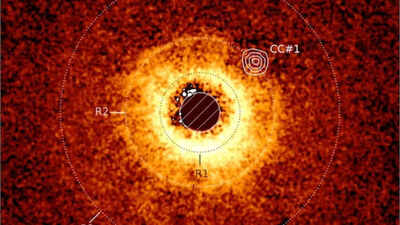The James Webb Space Telescope (JWST) has achieved a significant milestone by directly imaging its first new planet, TWA 7b. This discovery marks a major advancement in the field of exoplanet research.

An artist's rendering depicts the James Webb Space Telescope's groundbreaking discovery of exoplanet TWA 7b.
Designated TWA 7b, this newly discovered exoplanet is the lowest-mass planet ever directly imaged outside of our solar system. Its mass is estimated to be only 0.3 times that of Jupiter, or approximately 100 times the mass of Earth. This makes TWA 7b ten times lighter than any exoplanet previously observed through direct imaging.
The exoplanet orbits a young, low-mass star named CE Antliae (TWA 7), situated roughly 111 light-years away in the constellation Antlia. The star, identified in 1999, is a member of the TW Hydrae Association, a cluster of stars known for their youth. CE Antliae is estimated to be a mere 6.4 million years old, a cosmic infant compared to our Sun's 4.6 billion years. Its youth and near pole-on orientation relative to Earth made it an ideal target for JWST's imaging capabilities.
The discovery of TWA 7b relied on infrared imaging. Young, low-mass planets emit thermal radiation in the infrared spectrum. JWST's Mid-Infrared Instrument (MIRI), equipped with a coronagraph, was crucial in this observation.
A coronagraph blocks the intense light of a star, enabling the detection of faint, nearby objects like exoplanets. By employing high-contrast imaging techniques, the JWST team detected a faint infrared source embedded within the debris disc surrounding TWA 7.
This faint source resides within a gap between dust rings, an area theorized to be created by a planet's gravitational influence. Simulations confirmed that a planet with a mass similar to Saturn, located in that specific position, could account for the observed structure.
The disc around TWA 7 exhibits three distinct rings with gaps between them. One of these gaps features a narrow ring flanked by dust-free regions, a signature often linked to the gravitational effects of an orbiting planet. The infrared glow detected by JWST precisely corresponds to this ring gap. Its brightness, temperature (approximately 320 Kelvin or 47°C), and orbital distance (around 50 astronomical units from the star) align with scientists' expectations for a planet in this region.
The discovery of TWA 7b is significant for several reasons:
Astronomers believe that the structures observed in debris discs around young stars provide insights into planetary formation. These rings and gaps represent areas where material is either accumulating to form planets or being cleared out by their gravitational pull. TWA 7b may be the first direct evidence of this process in action.
Researchers used advanced image subtraction methods to detect TWA 7b. By removing residual starlight, they were able to isolate the planet from other celestial objects. This demonstrates how new observing methods and instruments on JWST, such as the coronagraph and MIRI, are expanding our ability to discover previously inaccessible exoplanets. JWST's mid-infrared sensitivity allows it to detect planets as massive and cold as Saturn, a significant improvement in direct imaging capabilities.
JWST's ability to suppress starlight and detect the faint heat signatures of small, cold planets opens up new possibilities for exoplanet discovery. Astronomers are now optimistic that even lighter planets, potentially Neptune-mass or even super-Earths, could soon be within reach.
Future observations will aim to:
Newer articles
Older articles
 Rishabh Pant's Game-Changing Innings Draw Adam Gilchrist Comparisons, Says Greg Chappell
Rishabh Pant's Game-Changing Innings Draw Adam Gilchrist Comparisons, Says Greg Chappell
 Greg Chappell: Rishabh Pant's Explosive Batting Redefining Cricket
Greg Chappell: Rishabh Pant's Explosive Batting Redefining Cricket
 Birmingham Nets Offer Clues: Bumrah's Intent and Kuldeep's Drive Ahead of Second Test
Birmingham Nets Offer Clues: Bumrah's Intent and Kuldeep's Drive Ahead of Second Test
 Gavaskar Calls for Kuldeep Yadav's Inclusion in Second Test Following India's Defeat Against England
Gavaskar Calls for Kuldeep Yadav's Inclusion in Second Test Following India's Defeat Against England
 Bollywood's "Swades" Anthem Joins Axiom-4 Mission, Fueling Indian Astronaut's Space Journey
Bollywood's "Swades" Anthem Joins Axiom-4 Mission, Fueling Indian Astronaut's Space Journey
 Stokes Lauds England's Openers for Setting Up Thrilling Chase Against India
Stokes Lauds England's Openers for Setting Up Thrilling Chase Against India
 Rogue Star Threat: Earth's Solar System Stability at Risk, New Study Warns
Rogue Star Threat: Earth's Solar System Stability at Risk, New Study Warns
 Bangladesh's Shadman Islam Defends Batting Lineup After Day 1 Setbacks Against Sri Lanka
Bangladesh's Shadman Islam Defends Batting Lineup After Day 1 Setbacks Against Sri Lanka
 Mirabai Chanu Reveals Relentless Focus on Training, Weight, and Sacrifices Required for Elite Weightlifting
Mirabai Chanu Reveals Relentless Focus on Training, Weight, and Sacrifices Required for Elite Weightlifting
 India Aims to Rewrite History in Birmingham Test After Headingley Setback
India Aims to Rewrite History in Birmingham Test After Headingley Setback